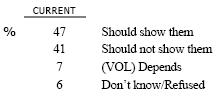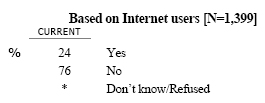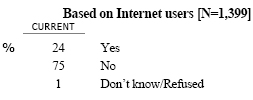Methodology
The results in this report are based on data from telephone interviews conducted by Princeton Survey Research Associates from May 15 to June 17, 2004, among a sample of 2,200 adults, 18 and older. For results based on the total sample, one can say with 95% confidence that the error attributable to sampling is plus or minus 2 percentage points. For results based Internet users (n=1,399), the margin of sampling error is plus or minus 3 percentage points. In addition to sampling error, question wording and practical difficulties in conducting telephone surveys may introduce some error or bias into the findings of opinion polls.
The sample for this survey is a random digit sample of telephone numbers selected from telephone exchanges in the continental United States. The random digit aspect of the sample is used to avoid “listing” bias and provides representation of both listed and unlisted numbers (including not-yet-listed numbers). The design of the sample achieves this representation by random generation of the last two digits of telephone numbers selected on the basis of their area code, telephone exchange, and bank number.
New sample was released daily and was kept in the field for at least five days. This ensures that complete call procedures were followed for the entire sample. Additionally, the sample was released in replicates to make sure that the telephone numbers called are distributed appropriately across regions of the country. At least 10 attempts were made to complete an interview at every household in the sample. The calls were staggered over times of day and days of the week to maximize the chances of making contact with a potential respondent. Interview refusals were recontacted at least once in order to try again to complete an interview. All interviews completed on any given day were considered to be the final sample for that day. The final response rate was 30.9%.
Non-response in telephone interviews produces some known biases in survey-derived estimates because participation tends to vary for different subgroups of the population, and these subgroups are likely to vary also on questions of substantive interest. In order to compensate for these known biases, the sample data are weighted in analysis. The demographic weighting parameters are derived from a special analysis of the Census Bureau’s March 2003 Annual Social and Economic Supplement Survey. This analysis produces population parameters for the demographic characteristics of adults age 18 or older, living in households that contain a telephone. These parameters are then compared with the sample characteristics to construct sample weights. The weights are derived using an iterative technique that simultaneously balances the distribution of all weighting parameters.
Questionnaire material
ONIM1 Over the past few months, photographs and videos have come out of Iraq containing graphic or disturbing images from the war. Some of these images have appeared in newspapers and on television. In general, do you think the media should or should not show these kinds of war images to the American public?

ONIM2 Have you, personally, seen any of the images from Iraq of…?

ONIM3 Some of these war images were deemed too graphic or disturbing to be shown on television or in newspapers, but were available on the Internet. Did you happen to see any of these images on the Internet?

ONIM4 Did you actively search for those images, or did you come across them while doing something else online?

ONIM5 In the end, did you feel that looking at the images available on the Internet was a good decision, or did you wish you hadn’t seen them?

ONIM6 In general, do you APPROVE or DISAPPROVE of these kinds of images being available on the Internet, when other media outlets like television and newspapers decide not to show them?

ONIM7 Apart from the war images that have come out of Iraq, have you ever searched online for particular news stories, photographs, or videos that media outlets decided NOT to cover?



